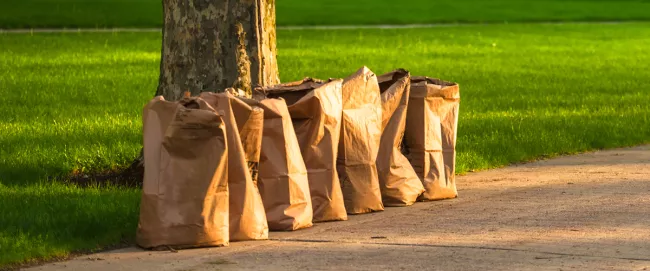Leaf, Yard and Christmas Tree Waste
Residents can purchase a backyard composter and leave grass clippings on the lawn to decrease the amount of leaf and yard waste placed at the curb.
These simple actions make a difference in the City’s Green Directions Vaughan Community Sustainability and Environmental Master Plan and York Region’s Waste Management Master Plan called the SM4RT Living Plan.
Christmas tree collection
During the first two weeks of January, the City will collect real Christmas trees in both blue and yellow zones on your scheduled collection day. Artificial trees are collected as garbage and must be bagged.
For the safety of the City’s waste collectors, keep these tips in mind:
- Do not place your real Christmas tree in a tree bag or plastic bag.
- Remove all decorations (including tinsel and ornaments) and stands from trees before collection.
- If you have broken glass, safely package the pieces in a sealed cardboard box labelled “broken glass.”
- Ensure your tree is less than two metres (seven feet) in height. Cut the tree in half if it exceeds this height.
- Do not place trees on the road, on top of or behind snowbanks.
Real Christmas trees can also be dropped off at a York Region waste depot that accepts yard waste (fees will apply). Visit york.ca/WasteDepots for more information.
If you have leftover leaf and yard waste, you can also place them curbside during Christmas tree collection.
Leaf and yard waste collection
Leaf and yard waste is collected seasonally and waste must be bundled, bagged or set out in waste containers. Designated open-top rigid containers, such as regulation sized garbage containers that are black or grey in color and marked ‘Leaf and Yard Waste’.
Protect yard waste bags from getting wet!
Overweight or broken bags cannot be collected. Keep your bags dry and only set out on collection day.
Yard waste must be placed at the curb no earlier than 6 p.m. the night before and no later than 7 a.m. on the day of collection. The time of collection can change without notice. Companies hired for lawn care services must be notified of these requirements.
Acceptable bags, bundles and bins
- Kraft paper bags designed for leaf and yard waste material
- Designated open-top rigid containers such as regulation sized garbage containers that are black or grey in colour and marked ‘Leaf and Yard Waste’
- Individual branches must be a maximum of 10 centimetres (four inches) in diameter
- Branches must be tied with string (no wire) in secure bundles maximum 1.5 metres (five feet) in length and 0.6 metres (two feet) in diameter
Unacceptable containers
- Plastic bags
- Cardboard boxes
- Oversized rigid containers
- Green organic bins
- Recycling blue boxes
- Any bin that is green or blue in colour
- Rigid containers with lids
- Bundles tied with wire
What goes in yard waste?
Trees and plants
- Leaves
- Branches
- Twigs
- Flowers and plants
- Vegetable garden waste
- Shrubs
- Weeds
Seasonal decor
- Pumpkins
- Straw
- Cornstalks
Unacceptable leaf and yard waste materials
- Stumps and root balls
- Soil, rocks, or stones
Grasscycling
Leave grass clippings on the lawn after a fresh cut to allow them to break down naturally. Learn more about grasscycling.
Leaf and yard waste can help pollinators
Pollinators, which include bees, butterflies, birds, beetles and bats, move pollen from one plant to another to allow plants and crops to grow. One out of every three bites of food we eat is thanks to pollinators. However, various impacts such as disease, climate change, pesticides, limited habitats and pests have stressed pollinators leading to a decline in their population. We all have a role to play to ensure pollinators remain protected – and your seasonal leaf and yard waste can help!
What you can do for pollinators in the fall
During the fall, consider keeping some leaves on the ground to provide pollinators with shelter throughout the winter.
What you can do for pollinators in the spring
Help protect pollinators by delaying any seasonal yard work to later in the spring when temperatures are around 15 degrees Celsius and above. Some pollinators use leaves and twigs as their habitat during the winter and cleaning these items up too early could hurt them. Weekly leaf and yard waste collection begins in late April each year.
Plant pollinator gardens when temperatures are consistently warm in the spring to support plants that will help pollinators grow new crops. Learn more about pollinators and some native plants that are pollinator friendly, including different types of milkweed, black-eyed Susan, and Red-Osler Dogwood.

